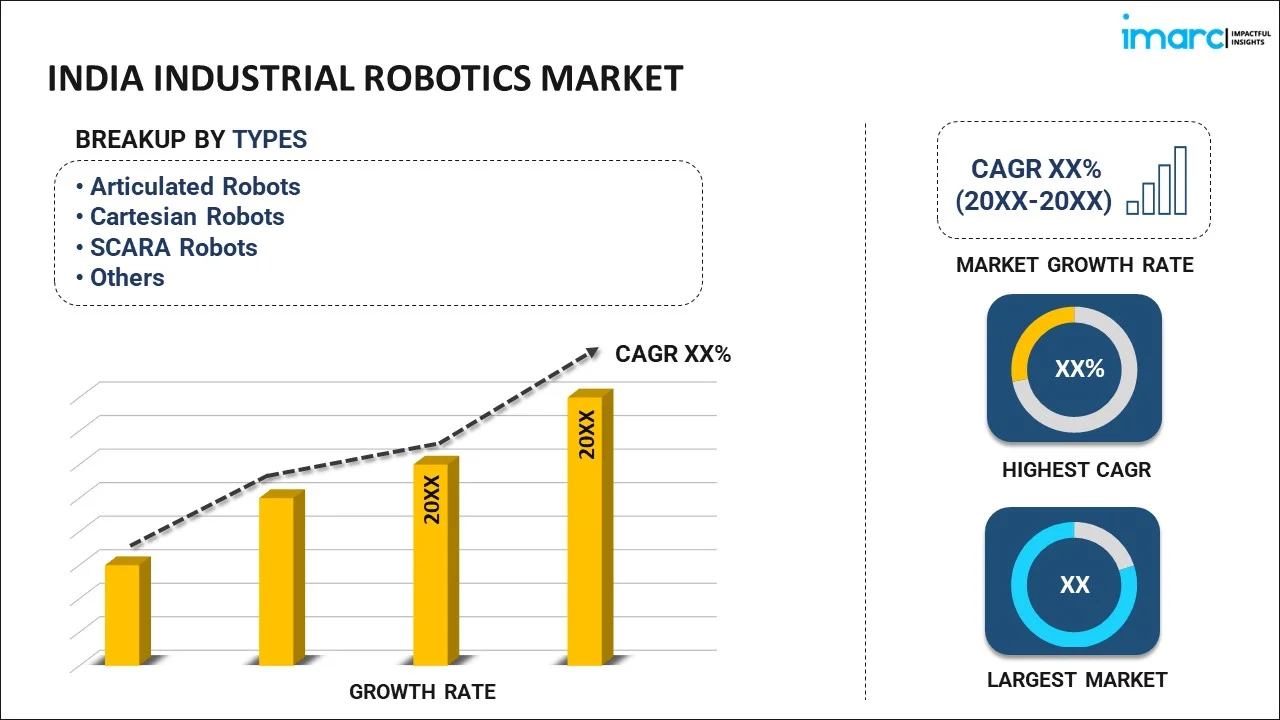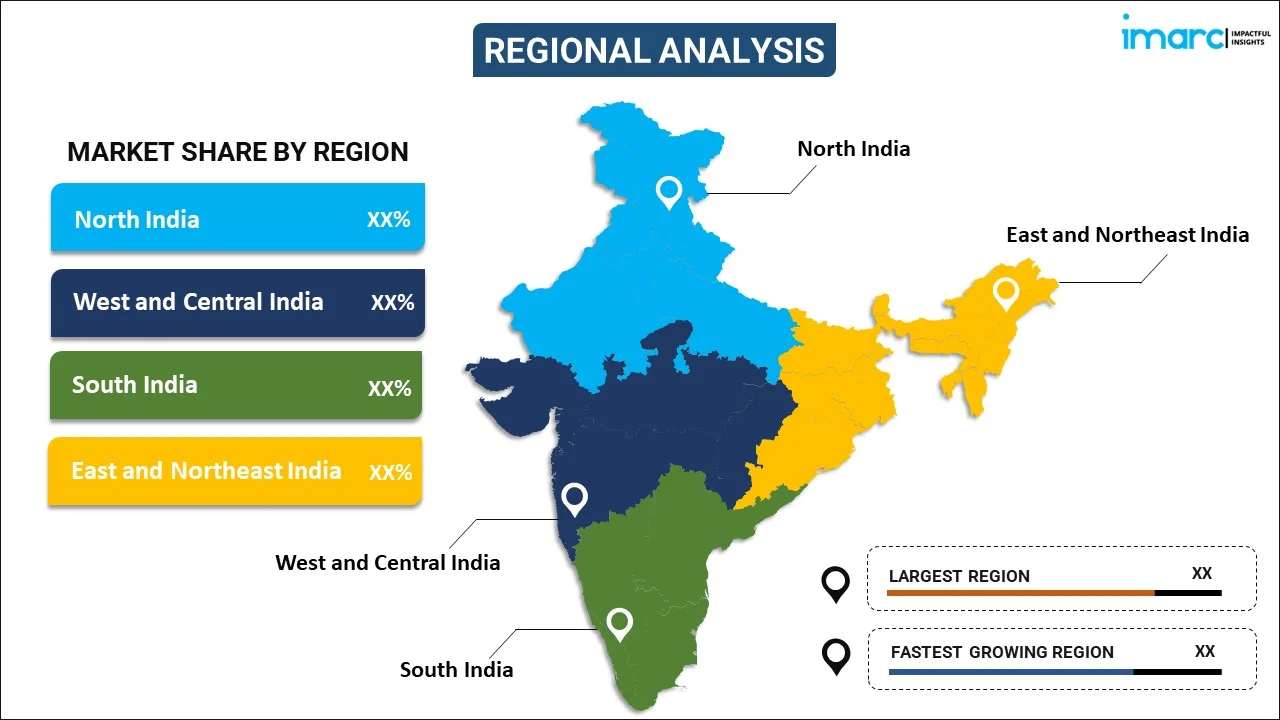
India Industrial Robotics Market Report by Type (Articulated Robots, Cartesian Robots, SCARA Robots, Cylindrical Robots, Parallel Robots, and Others), Function (Soldering and Welding, Materials Handling, Assembling and Disassembling, Painting and Dispensing, Milling, Cutting and Processing, and Others), End Use Industry (Automotive, Electrical and Electronics, Chemical, Rubber, and Plastics, Machinery and Metals, Food and Beverages, Precision and Optics, Pharmaceutical, and Others), and Region 2025-2033
Market Overview:
India industrial robotics market size reached 6.5 Thousand Units in 2024. Looking forward, IMARC Group expects the market to reach 26.7 Thousand Units by 2033, exhibiting a growth rate (CAGR) of 16.7% during 2025-2033. The ongoing advancements in robotics technology, including sensors, machine vision, and artificial intelligence, which enhance the capabilities of industrial robots, are driving the market.
|
Report Attribute
|
Key Statistics
|
|---|---|
|
Base Year
|
2024
|
|
Forecast Years
|
2025-2033
|
|
Historical Years
|
2019-2024
|
|
Market Size in 2024
|
6.5 Thousand Units |
|
Market Forecast in 2033
|
26.7 Thousand Units |
| Market Growth Rate 2025-2033 | 16.7% |
Industrial robotics refers to the use of specialized robotic systems within manufacturing and industrial settings to automate tasks traditionally performed by humans. These robots are designed to execute repetitive, precise, and often dangerous tasks, enhancing efficiency, accuracy, and safety in various industries. Equipped with sensors, actuators, and sophisticated programming, industrial robots can perform functions such as assembly, welding, painting, packaging, and material handling. The integration of robotics in industrial processes leads to increased productivity, reduced production costs, and improved product quality. Advancements in technology, such as artificial intelligence and machine learning, contribute to the development of more versatile and adaptable robotic systems. Industrial robotics plays a pivotal role in modern manufacturing, revolutionizing production lines and contributing to the evolution of smart factories and the broader concept of Industry 4.0.
India Industrial Robotics Market Trends:
The industrial robotics market in India is experiencing robust growth, primarily driven by the escalating demand for automation across various industries. With the relentless pursuit of efficiency and productivity, businesses are increasingly turning to industrial robotics to streamline their operations. Moreover, the growing emphasis on precision and quality in manufacturing processes has fueled the adoption of robotic solutions, enhancing overall production standards. Furthermore, the advent of Industry 4.0 and the Internet of Things (IoT) has revolutionized manufacturing paradigms, creating a conducive environment for the integration of advanced robotics. As a result, the industrial robotics market is witnessing a surge in demand for smart, interconnected robotic systems capable of real-time data exchange and decision-making. In addition to technological advancements, cost-effectiveness remains a pivotal driver for the widespread adoption of industrial robotics. The decreasing costs of robotic components, coupled with advancements in artificial intelligence, have made robotics more accessible to a broader spectrum of industries, ranging from automotive to healthcare. In conclusion, a confluence of factors, including the pursuit of operational excellence, technological innovation, and cost efficiencies, are propelling the industrial robotics market forward in India in the coming years.
India Industrial Robotics Market Segmentation:
IMARC Group provides an analysis of the key trends in each segment of the market, along with forecasts at the country level for 2025-2033. Our report has categorized the market based on type, function, and end use industry.
Type Insights:

- Articulated Robots
- Cartesian Robots
- SCARA Robots
- Cylindrical Robots
- Parallel Robots
- Others
The report has provided a detailed breakup and analysis of the market based on the type. This includes articulated robots, cartesian robots, SCARA robots, cylindrical robots, parallel robots, and others.
Function Insights:
- Soldering and Welding
- Materials Handling
- Assembling and Disassembling
- Painting and Dispensing
- Milling, Cutting and Processing
- Others
A detailed breakup and analysis of the market based on the function have also been provided in the report. This includes soldering and welding, materials handling, assembling and disassembling, painting and dispensing, milling, cutting and processing, and others.
End Use Industry Insights:
- Automotive
- Electrical and Electronics
- Chemical, Rubber, and Plastics
- Machinery and Metals
- Food and Beverages
- Precision and Optics
- Pharmaceutical
- Others
The report has provided a detailed breakup and analysis of the market based on the end use industry. This includes automotive, electrical and electronics, chemical, rubber, and plastics, machinery and metals, food and beverages, precision and optics, pharmaceutical, and others.
Regional Insights:

- North India
- West and Central India
- South India
- East and Northeast India
The report has also provided a comprehensive analysis of all the major regional markets, which include North India, West and Central India, South India, and East and Northeast India.
Competitive Landscape:
The market research report has also provided a comprehensive analysis of the competitive landscape in the market. Competitive analysis such as market structure, key player positioning, top winning strategies, competitive dashboard, and company evaluation quadrant has been covered in the report. Also, detailed profiles of all major companies have been provided.
India Industrial Robotics Market Report Coverage:
| Report Features | Details |
|---|---|
| Base Year of the Analysis | 2024 |
| Historical Period | 2019-2024 |
| Forecast Period | 2025-2033 |
| Units | Thousand Units |
| Scope of the Report | Exploration of Historical Trends and Market Outlook, Industry Catalysts and Challenges, Segment-Wise Historical and Future Market Assessment:
|
| Types Covered | Articulated Robots, Cartesian Robots, SCARA Robots, Cylindrical Robots, Parallel Robots, Others |
| Functions Covered | Soldering and Welding, Materials Handling, Assembling and Disassembling, Painting and Dispensing, Milling, Cutting and Processing, Others |
| End Use Industries Covered | Automotive, Electrical and Electronics, Chemical, Rubber, and Plastics, Machinery and Metals, Food and Beverages, Precision and Optics, Pharmaceutical, Others |
| Regions Covered | North India, West and Central India, South India, East and Northeast India |
| Customization Scope | 10% Free Customization |
| Post-Sale Analyst Support | 10-12 Weeks |
| Delivery Format | PDF and Excel through Email (We can also provide the editable version of the report in PPT/Word format on special request) |
Key Questions Answered in This Report:
- How has the India industrial robotics market performed so far and how will it perform in the coming years?
- What has been the impact of COVID-19 on the India industrial robotics market?
- What is the breakup of the India industrial robotics market on the basis of type?
- What is the breakup of the India industrial robotics market on the basis of function?
- What is the breakup of the India industrial robotics market on the basis of end use industry?
- What are the various stages in the value chain of the India industrial robotics market?
- What are the key driving factors and challenges in the India industrial robotics?
- What is the structure of the India industrial robotics market and who are the key players?
- What is the degree of competition in the India industrial robotics market?
Key Benefits for Stakeholders:
- IMARC’s industry report offers a comprehensive quantitative analysis of various market segments, historical and current market trends, market forecasts, and dynamics of the India industrial robotics market from 2019-2033.
- The research report provides the latest information on the market drivers, challenges, and opportunities in the India industrial robotics market.
- Porter's five forces analysis assist stakeholders in assessing the impact of new entrants, competitive rivalry, supplier power, buyer power, and the threat of substitution. It helps stakeholders to analyze the level of competition within the India industrial robotics industry and its attractiveness.
- Competitive landscape allows stakeholders to understand their competitive environment and provides an insight into the current positions of key players in the market.
Need more help?
- Speak to our experienced analysts for insights on the current market scenarios.
- Include additional segments and countries to customize the report as per your requirement.
- Gain an unparalleled competitive advantage in your domain by understanding how to utilize the report and positively impacting your operations and revenue.
- For further assistance, please connect with our analysts.
 Inquire Before Buying
Inquire Before Buying
 Speak to an Analyst
Speak to an Analyst
 Request Brochure
Request Brochure
 Request Customization
Request Customization




.webp)




.webp)












